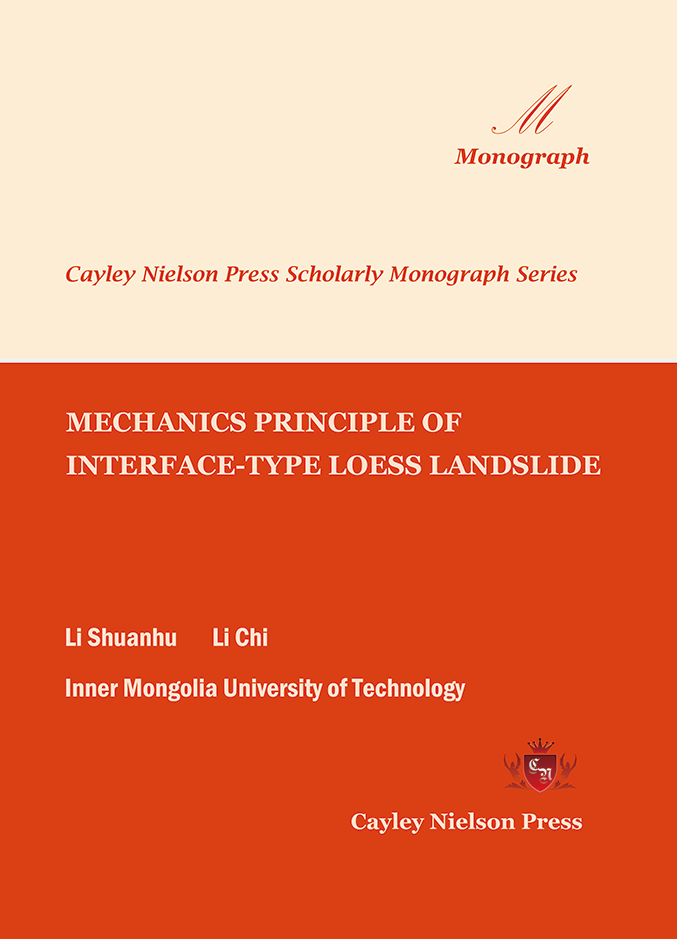
MECHANICS PRINCIPLE OF INTERFACE-TYPE LOESS LANDSLIDE

MECHANICS PRINCIPLE OF INTERFACE-TYPE LOESS LANDSLIDE
Li Shuanhu, Li Chi
Inner Mongolia University of Technology
Copyright © 2023 by Cayley Nielson Press, Inc.
ISBN: 978-1-957274-12-6
Cayley Nielson Press Scholarly Monograph Series Book Code No.: 213-3-1
US$165.50
Preface
In recent years, the loess landslides in the Loess Plateau region are at a high incidence period, and the number and scale of landslides are in a growing trend. Interfacial loess landslides are a type of loess landslides, which are widely distributed in the Loess Plateau region. The failure mechanism and instability mode of its sliding surface are relatively special. Therefore, the study of interface type loess landslide disasters is not only a scientific demand, but also a demand for social and economic development. Currently, scholars in relevant fields are gradually paying attention to it.
The current research theory for interfacial loess landslides is relatively lagging behind. Therefore, this book provides a detailed theoretical study on the failure mechanism and calculation model of interface type loess landslides, and provides a clear theoretical derivation process and application methods. The research process involves interdisciplinary research in soil mechanics, elastic-plastic mechanics, fracture mechanics, structural mechanics, theoretical mechanics, and other disciplines, which not only reflects the multi-angle nature of research issues, but also reflects the multi-scale nature of research issues.
This book proposes a soil yield failure mode with fracture characteristics based on traditional soil yield failure criteria by studying the failure mechanism of sliding surface soil. The physical significance of sliding zone failure is explained from the perspective of fracture mechanics, and a fracture progressive failure mode of soil landslides is proposed based on the traditional slice progressive failure mode. Based on the principle of fracture mechanics, a mechanical equilibrium equation based on J integral is presented. In the interface type loess landslide with low water content or high consolidation stress, it is feasible and applicable to use the fracture progressive failure mode to study soil failure, and its physical significance is clearer and its application prospects are better.
Based on the theory of asperity, an instability model of interface type loess landslides is established. The asperity theory and progressive fracture failure mode jointly solve the theoretical problems of interface type loess landslides, and provide direct theoretical support for the design of monitoring and warning schemes for landslides, which has important engineering value.
Li Shuanhu
Li Chi
Hohhot, Inner Mongolia Autonomous Region, China
February 12, 2023
Contents
1 General mechanical calculation of interface-type loess landslide 1
1.1 Introduction 1
1.2 Limit equilibrium analysis of interface-type loess landslide 2
1.3 Yield limit of interface-type loess landslide 5
1.4 Progressive damage model of interface-type loess landslides 7
1.5 Chapter summary 12
2 Asperity theoretical model of interface-type loess landslide 14
2.1 Introduction 14
2.2 Basic concepts of asperity theory 15
2.3 Mechanical characteristics of asperities in interface-type loess landslides 18
2.4 Asperity classification in interface-type loess landslides 22
2.5 Chapter summary 24
3 Fracture failure characteristics of interface-type loess landslide 25
3.1 Introduction 25
3.2 Failure criterion of interface-type loess landslide 25
3.3 Asperity failure mode of interface-type loess landslide 29
3.4 Fracture progressive damage of interface-type loess landslides 31
3.5 Chapter summary 34
4 Fracture mechanics analysis of asperity in interface-type loess landslide 36
4.1 Introduction 36
4.2 Linear elastic fracture mechanism of loess landslide 36
4.2.1 Fracture strength factor K 38
4.2.2 Fracture energy release rate G 43
4.3 Nonlinear elastic fracture mechanism of loess landslide 45
4.3.1 Crack opening displacement theory COD 46
4.3.2 J-integral theory of shear fracture 48
4.3.3 J-Integral equilibrium equation of shear sliding zone 52
4.3.4 J-Integral equilibrium equation of stretch sliding zone 57
4.4 Chapter summary 60
5 J-integral starting conditions for different failure modes of interface-type loess landslides 62
5.1 Introduction 62
5.2 J-integral equilibrium equation of tractive loess landslide 62
5.3 J-integral equilibrium equation of pushing loess landslide 71
5.4 J-integral equilibrium equation of tensile loess landslide 76
5.5 Chapter summary 80
6 Mechanical equilibrium equations of asperity in interface-type loess landslides 82
6.1 Introduction 82
6.2 Mechanical solution of the limit length Lc of the sliding belt 82
6.3 Mechanical solution of the length ω of the tip region 86
6.4 Chapter summary 91
7 Limit length of sliding zone of interface-type loess landslide with different asperities 92
7.1 Introduction 92
7.2 Fluctuating asperity 92
7.3 Critical asperity 96
7.4 Structural asperity 98
7.5 Composite asperity 100
7.6 Chapter summary 102
8 Combination form and calculation scheme of asperity in interface-type loess landslide 103
8.1 Introduction 103
8.2 Two-dimensional monomer combined asperity 103
8.3 Two-dimensional primary and secondary combination asperity 107
8.4 Three-dimensional combined asperity 114
8.5 Chapter summary 126
9 Applicability analysis of asperity theory in interface-type loess landslide 127
9.1 Introduction 127
9.2 Mechanical basis of asperity theory 128
9.3 Application scheme of asperity theory 130
9.4 Chapter summary 132
References 134
Readership
This book should be useful for students, scientists, engineers and professionals working in the areas of optoelectronic packaging, photonic devices, semiconductor technology, materials science, polymer science, electrical and electronics engineering. This book could be used for one semester course on adhesives for photonics packaging designed for both undergraduate and graduate engineering students.
